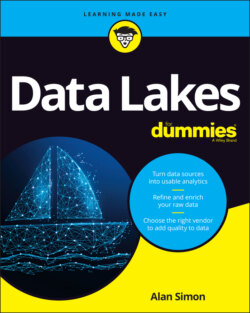Читать книгу Data Lakes For Dummies - Alan R. Simon - Страница 43
Dealing with the data fragmentation problem
ОглавлениеA lofty vision is one thing; reality is often something else. Figure 2-2 illustrates how almost every organization’s idea of centralized, enterprise-scale data warehousing eventually surrendered to a landscape littered with numerous stand-alone, nonintegrated data marts.
Okay, so maybe the idea of “Do your own thing, and build your own data mart” got out of control. Now that you can see what a mess that approach created, why not just retire those data marts and fold them into your enterprise data warehouse that’s probably underutilized?
A collection of independent data marts is almost always hampered by a lack of common master data (for example, to sales, a “customer” may be something different than a “customer” is to your marketing team), different software packages and technologies across the data marts, and other challenges. Taken together, these challenges make it almost impossible to consolidate separate, independent data marts back into a single data warehouse. Most organizations instead throw their hands up in the air and say that they’re following a federated data warehouse approach. You “create” a federated data warehouse by simply declaring that some or all of your data marts are part of a “federation” that, when considered together, are sort of like a data warehouse. “Um … yeah, that’s our story, and we’re sticking to it. It’s magic!” (Not really … and not all that valuable from an enterprise-wide perspective.)
FIGURE 2-2: The reality of numerous stand-alone data marts.
